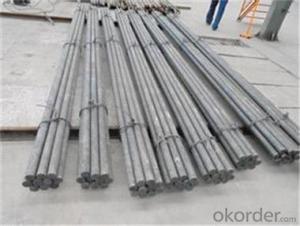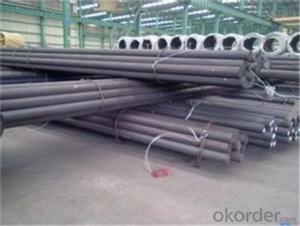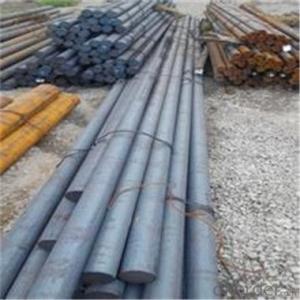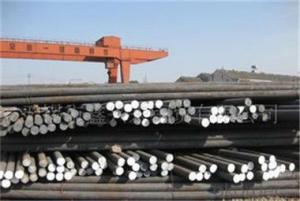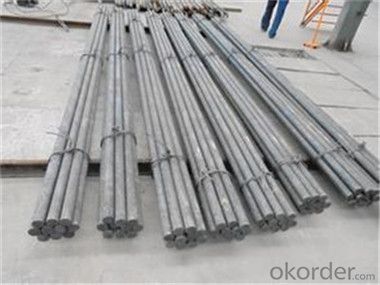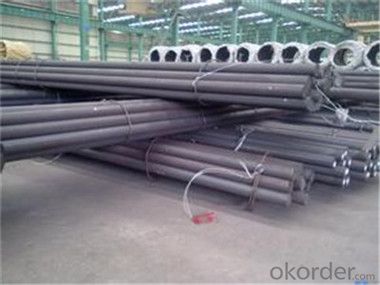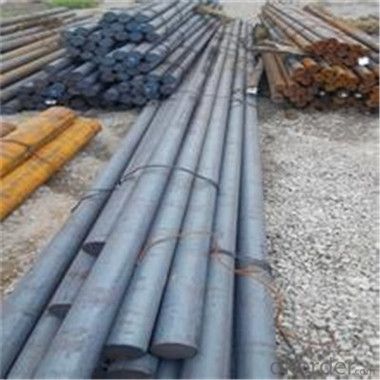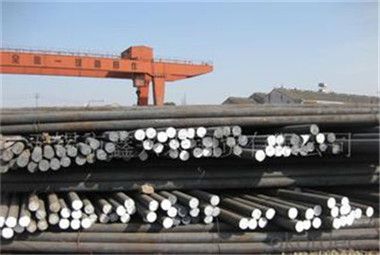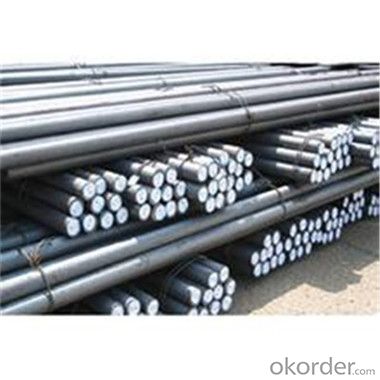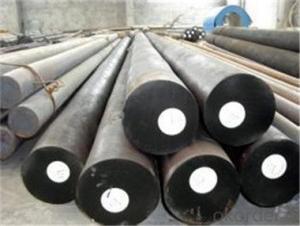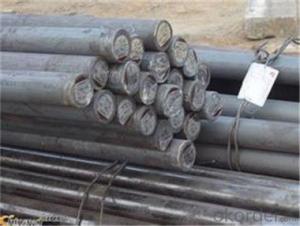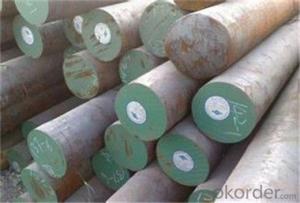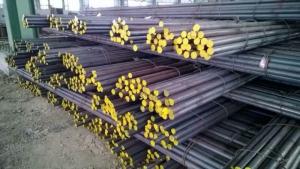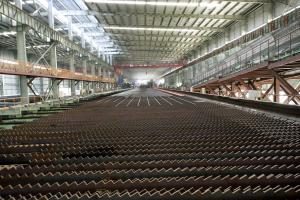Hot Rolled Carbon Steel Round Bar MS Bar -China CNBM
- Loading Port:
- Tianjin
- Payment Terms:
- TT OR LC
- Min Order Qty:
- 667 m.t.
- Supply Capability:
- 2000000 m.t./month
OKorder Service Pledge
OKorder Financial Service
You Might Also Like
Description of steel round bar:
1. Commodity: Round steel bar
3. Technical: Hot rolling
2. Length: Min. 5.8meter, according to requirement.
3. Diameter: 16mm-250mm
5. Packing: In Bundle or according to your requirements.
Festures of steel round bar:
Description : Steel Bar/Stainless Steel Round Bar/Alloy Steel Round Bar/Carbon Steel Bar
Stainless Steel Bright Bar/Stainless Steel Peeled Bar/Stainless Steel Polishing Bar
Diamater:
1 Hot rolled round bar diameter from 5.5mm to 110mm
2.Hot forged round bar diameter from 110mm to 400mm
3.Cold drawn round bar diameter from 2.0mm to 60mm
Specifications of steel round bar:
Length: standard 6m,9m,12m, or as customers' requirement
Surface: Black, polished, grinded, ,Bright, Turn smooth(Peeled),Brush,Mill,Pickled
Process:Hot rolled,cold drawn,forged
Images of steel round bar:
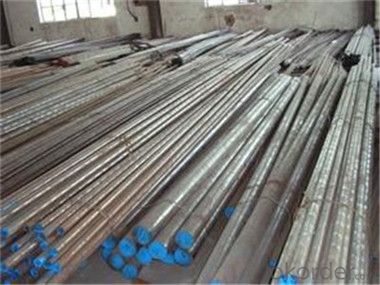
FAQ:
1. How long is the lead time?
Delivery time: 45 days after order confirmed.
2. What payment term do you accept?
Payment: T/T or L/C at sight.
- Q: What are the different types of steel round bar surface finishes for improved aesthetics?
- Some common types of steel round bar surface finishes for improved aesthetics include polished, brushed, satin, and bead blasted finishes.
- Q: How do steel round bars compare to wrought iron bars?
- Steel round bars and wrought iron bars exhibit distinct disparities that distinguish them from each other. To begin with, steel round bars consist of an amalgam of iron and carbon, while wrought iron bars are comprised of pure iron with a low carbon content. This dissimilarity in composition results in contrasting properties. Steel round bars are renowned for their robustness and endurance, rendering them suitable for a wide array of purposes, including construction, manufacturing, and engineering. Conversely, wrought iron bars are pliable and more malleable, enabling them to be easily fashioned and molded into intricate designs. This characteristic renders wrought iron bars popular in decorative applications such as gates, fences, and ornamental pieces. Another distinction lies in their manufacturing processes. Steel round bars are typically manufactured through the process of hot rolling, which encompasses heating the steel billet and passing it through a series of rollers to fashion it into the desired round bar form. In contrast, wrought iron bars are formed via a labor-intensive procedure known as blacksmithing. This involves heating the iron and repeatedly pounding it to eliminate impurities and construct a fibrous structure, thereby resulting in its distinctive grainy appearance. In terms of expenses, steel round bars generally prove to be more economical compared to wrought iron bars. The manufacturing process for steel is more streamlined and efficient, thereby leading to reduced production costs. Conversely, wrought iron bars necessitate more time and labor, rendering them pricier. Finally, concerning corrosion resistance, steel round bars hold an advantage. Steel can be further alloyed with elements such as chromium, nickel, and molybdenum to augment its resistance against rust and corrosion. This renders steel round bars suitable for outdoor applications where they may encounter moisture and harsh environmental conditions. Wrought iron bars, although possessing some level of corrosion resistance, are more susceptible to rusting and require regular maintenance to prevent deterioration. In conclusion, steel round bars and wrought iron bars differ in terms of composition, strength, manufacturing process, cost, and corrosion resistance. The selection between the two relies on the specific requirements of the application, with steel round bars being favored for their strength and affordability, while wrought iron bars are often chosen for their malleability and decorative allure.
- Q: Is there any technique for welding round steel?
- Welding skills:2.1, to determine the best welding position, the group of good welding flat, easy to rotate welding, the weld pool is always in flat position, note the rod angle at 70 degrees.2.2, the welding workpiece in continuous continuous rotation, to control the size of the weld pool at the end of each lap weld slag, cleaned, and then welding together, the thickness of each layer is about 2mm, until the full fill slope has so far.
- Q: Can steel round bars be used in marine environments?
- Yes, steel round bars can be used in marine environments, but they need to be made from corrosion-resistant materials such as stainless steel or galvanized steel to withstand the corrosive effects of saltwater.
- Q: What are the different types of steel round bar sizes?
- Steel round bars come in a variety of sizes, each serving different purposes and applications. The most common sizes for steel round bars range from 1/8 inch to 24 inches in diameter. These sizes are typically measured in inches, with each increment representing a larger diameter. For smaller projects or more intricate designs, steel round bars ranging from 1/8 inch to 1 inch are often used. These smaller sizes are commonly found in jewelry making, crafting, and smaller construction projects. On the other hand, steel round bars ranging from 1 inch to 24 inches are utilized for larger-scale applications such as structural support, manufacturing, or industrial projects. These larger sizes provide enhanced strength and durability, making them suitable for heavy-duty use. It should be noted that steel round bars are also available in metric sizes, which are measured in millimeters. Metric sizes are commonly used in regions that follow the metric system, such as many countries in Europe and Asia. Choosing the appropriate size of steel round bar depends on the specific requirements of the project, including load-bearing capacity, structural integrity, and overall design. It is advisable to seek advice from an engineer or industry professional to determine the most suitable size for your particular application.
- Q: What's the difference between round steel and screw steel? Which is cheaper than steel on the market these days?
- Steel is known as hot rolled ribbed bar. The specification of rebar is large, and it belongs to small section steel. It is mainly used for the skeleton of reinforced concrete construction component. Generally required in the use of a certain mechanical strength, bending deformation properties and welding process performance.
- Q: Can steel round bars be bent or formed into different shapes?
- Yes, steel round bars can be bent or formed into different shapes through various processes such as hot or cold bending, machining, or using specialized equipment like a pipe bender or a press brake.
- Q: Are steel round bars suitable for use in the construction of bridges?
- Indeed, steel round bars prove to be a suitable choice for the construction of bridges. Offering a multitude of advantages, they are an ideal option for such projects. To begin with, steel round bars exhibit remarkable tensile strength, enabling them to withstand substantial loads and forces without undergoing deformation or breakage. This attribute holds paramount importance for bridges, as they bear the weight of vehicles and pedestrians. By possessing high tensile strength, steel round bars ensure the structural integrity and safety of the bridge. Furthermore, steel round bars boast exceptional durability and resistance to corrosion. Considering the exposure of bridges to adverse environmental conditions like rain, snow, and saltwater, materials employed in their construction are susceptible to corrosion and deterioration. However, steel round bars are specifically designed to counteract these effects, guaranteeing the longevity and dependability of the bridge. Moreover, steel round bars are widely available in various sizes and lengths, catering to the versatility and adaptability required for different bridge designs and configurations. The uniform circular shape of these bars simplifies the construction process, enabling easy cutting, bending, and welding to meet the necessary specifications. In addition, steel round bars offer cost-effectiveness in bridge construction. Their favorable strength-to-weight ratio allows them to provide the required strength while minimizing the overall weight of the bridge. Consequently, this reduces the amount of material needed and lowers transportation costs during construction. In conclusion, steel round bars are highly suitable for bridge construction due to their high tensile strength, durability, corrosion resistance, versatility, and cost-effectiveness. They deliver the necessary strength and reliability to support heavy loads and withstand adverse environmental conditions, ensuring the safety and durability of the bridge.
- Q: What are the different treatments available for steel round bars?
- Depending on the desired properties and applications, there are several treatment options available for steel round bars. Some commonly used treatments are as follows: 1. Altering the mechanical properties of steel round bars can be achieved through heat treatment. This involves heating the bars to a specific temperature and then cooling them rapidly or slowly. By doing so, hardness, strength, toughness, and resistance to wear and corrosion can be improved. 2. To increase hardness, quenching can be employed. This entails rapidly cooling the heated steel round bars in a liquid medium, such as water or oil. Following quenching, tempering is carried out by reheating the steel to a lower temperature. This reduces brittleness and enhances toughness. 3. Surface hardening is a treatment method used to enhance the hardness of the outer layer of steel round bars while maintaining a tough and ductile core. Common techniques for surface hardening include carburizing, nitriding, and induction hardening. 4. Cold working involves deforming the steel at room temperature through processes like rolling, drawing, or extrusion. This treatment strengthens and increases the hardness of the steel round bars. Additionally, it improves dimensional accuracy and surface finish. 5. To enhance resistance to corrosion and wear, a protective coating can be applied to steel round bars. Zinc plating, galvanizing, and various types of paint or epoxy coatings are commonly used for this purpose. 6. Shot blasting is a treatment technique where small metallic or abrasive particles are shot at high speeds onto the surface of the steel round bars. This process removes contaminants, scale, and rust, resulting in a clean and polished surface. It is important to consider the specific requirements of the steel round bars and the intended application when choosing a treatment method. Consulting with experts or metallurgists is recommended to determine the most suitable treatment for a particular situation.
- Q: The difference between galvanized round bar and galvanized flat steel
- Galvanized round steel refers to the cross section of round solid steel. The specifications are expressed in millimeters of diameter, such as 50, which means a round bar of 50 millimeters in diameter. Round steel is not the same as other steel bars. Round steel is round in shape and has no ribs and no ribs, which makes the bonding strength between round bar and concrete very small.
Send your message to us
Hot Rolled Carbon Steel Round Bar MS Bar -China CNBM
- Loading Port:
- Tianjin
- Payment Terms:
- TT OR LC
- Min Order Qty:
- 667 m.t.
- Supply Capability:
- 2000000 m.t./month
OKorder Service Pledge
OKorder Financial Service
Similar products
Hot products
Hot Searches
Related keywords
